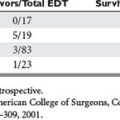CHAPTER 104 PALLIATIVE CARE IN THE TRAUMA INTENSIVE CARE UNIT
Despite many recent advances in trauma resuscitation and surgery, surgeons continue to care for critically injured patients who will succumb to their injuries. The mortality rate for trauma patients who require admission to the intensive care unit (ICU) remains at 10%–20%, and an additional percentage of those who survive will be significantly disabled or functionally impaired. Appropriate and compassionate care for the dying trauma patient as well as management of pain and symptoms in all critically ill patients are now part of good-quality trauma care. Aggressive pain management or comfort measures causing physiologic hemodynamic derangements or masking symptoms in the critically injured are no longer of great concern. Newer information and selection of appropriate medications now make clear that attention to pain management and comfort can be successfully provided during ongoing resuscitation without ill effects. The skills of the trauma surgeon encompass basic palliative care principles as they apply to the critically ill trauma patient; facility with an interdisciplinary team approach, communication of bad news, pain and symptom management, and withholding and withdrawal of life support.
WHEN TO START PALLIATIVE CARE IN ICU
While mortality from injury is correlated with Injury Severity Score and increasing age, prognosis on admission to the ICU is not always clear for every patient. The majority of trauma deaths in the ICU occur in the first 48 hours secondary to traumatic brain injury or traumatic hemorrhage, while another significant proportion (20%–30%) will linger in the ICU only to die weeks later from sepsis and multiple organ failure. In the first group, catastrophic injuries have a rapid trajectory toward death, usually with prognostic certainty; here palliative care should be started early in the ICU course, shortly after admission. In this context, bereavement support and communication with the family while attending to patient care are crucial. This early support sets the stage for later decision making, minimizes conflict and has a salutary effect on family grief, bereavement, and even organ donation rates. For patients who have a protracted course and uncertain prognosis, waiting for death to be imminent before instituting palliative care means that many patients will receive end-of-life care late, have untreated suffering and symptoms, or remain on life support long after it is futile. Thus, palliative care in some form should start early in this group as well, regardless of ultimate outcome.
All trauma patients are admitted to the ICU with the hope and expectation for life-saving care, not only on the part of their families, but physicians and nurses as well. The transition in goals of care to palliative can seem daunting in the face of these hopes. This transition is best initiated on admission with a simple palliative care assessment for likely prognosis, even if the possible outcomes are uncertain. Assessment should include not just survival and mortality risk, but expected long-term quality of life and function. If a poor outcome is possible or expected, an interdisciplinary assessment should follow of pain and symptoms, family psychosocial needs, proxy decision makers, presence of advance directives or patient preferences regarding care, and spiritual issues (Table 1).
Table 1 Palliative Care Assessment on Admission to Trauma ICU
| Pain and symptom assessment |
| 1. Pain score_____ 2. Anxietyv_____ 3. Agitation score_____ 4. Dyspnea_____ |
| Outcome and prognosis assessment |
WHAT IS PALLIATIVE CARE IN THE ICU?
These four components of palliative care are essential for good quality care for trauma patients in the ICU. Evidence suggests that implementation of these components in a pathway or bundle improves many aspects of care. Integration of these four areas of assessment and management into standard critical care in a timed sequence ensures their application when appropriate. Assessment of patient, family, and prognosis is the first step, followed by appropriate family support, communication, and family meetings. From these steps, goals of care should be developed. This should be completed within 72 hours of admission (Table 2).
Table 2 Integrated Care Pathway: Essential Steps in Trauma ICU
| First 24 Hours | First 72 Hours | End-of-Life Care for Dying |
|---|---|---|
| Palliative care assessment: |
COMMUNICATION AND SHARED DECISION MAKING
Skills in communication, negotiation, and consensus building are essential for this process to be effective in the trauma ICU. The vast majority of critically ill patients lack capacity for communication due to injury or sedation, and their families must function as proxy decision makers. Direct communication with the family about the patient’s condition, proposed treatments, prognosis, and range of possible outcomes with each therapy should commence as soon as possible in the intensive care course. Questions on advance directives and patient preferences for or against life support should be posed. The earlier this happens, the less conflict will ensue in later discussions on end-of-life decisions, do-not-resuscitate orders, and withholding of life support. Conflict is most common between family and health care staff, usually when families want life-prolonging care that physicians deem to be futile. Good communication, education, and support in many cases will resolve conflict. Evidence is clear that a structured family meeting or communication within 72 hours of admission focused on goals of care improves quality of care, length of ICU stay, and patient and family satisfaction. Studies suggest that this meeting is most effective when it includes a proper setting and appropriate members of the team, and then assessment of family understanding, discussion of prognosis and goals of care, and provision of support, and concludes with recommendations for care (Table 3). In many instances, facilitation of the meeting is best done by social workers, bereavement counselors, or nurses who can provide emotional support for the family during difficult or conflicted decisions. The physician plays a critical role, however, in discussing prognosis and medical treatment options in a clear and direct fashion, and how each may or may not meet the patient’s goals of care. It is important also for the physician to make a recommendation for a care plan based on these discussions.
Adapted from Curtis JR, Patrick DL, Shannon SE, Treece PD, Engelberg RA, Rubenfeld GD: The family conference as a focus to improve communication about end-of-life care in the intensive care unit: opportunities for improvement. Crit Care Med 29(Suppl 2):N26–N33, 2001.
PAIN AND SYMPTOM MANAGEMENT
Quality care of the trauma patient in the ICU includes good pain and symptom management. Attention to relief of suffering is not only ethical and compassionate, but also abbreviates the sympathetic response and physiologic and immunologic derangements associated with surgical stress and painful injury. Studies suggest that inadequate treatment of pain and anxiety in the ICU can lead to long-term sequelae with post-traumatic stress disorder and poor psychosocial outcomes and function. Concerns that treatment of pain in the ICU will lead to hemodynamic or neurologic compromise are for the most part unfounded, and aggressive symptom control can be delivered in parallel with resuscitation in unstable patients. Short-acting agents such as fentanyl and propofol provide pain relief and deep sedation, respectively, in such situations. Newer agents such as dexemetomidine that sedate without respiratory compromise show promise as well.
Clarke EB, Curtis JR, Luce JM, et al. Quality indicators for end-of-life care in the intensive care unit. Robert Wood Johnson Foundation Critical Care End of Life Peer Workgroup Members. Crit Care Med. 2003;31:2255-2262.
Curtis JR, Patrick DL, Shannon SE, et al. The family conference as a focus to improve communication about end-of-life care in the intensive care unit: opportunities for improvement. Respir Care. 2000;45:1385-1394.
Lilly CM, De Meo DL, Sonna LA, et al. An intensive communication intervention for the critically ill. Am J Med. 2000;109:469-475.
Meyers TA, Eickhard DJ, Guzzzetta C, et al. Family presence during intensive procedures and resuscitation: the experience of family members, nurses and physicians. Am J Nurs. 2000;100:32-42.
Mosenthal AC, Lee KF, Huffman J. Palliative care in the surgical intensive care unit. J Am Coll Surg. 2002;194:75-83.
Mosenthal AC, Murphy PA. Interdisciplinary Model of Palliative Care in the Trauma/Surgical ICU. Princeton, NJ: Robert Wood Johnson Foundation, 2006. www.promotingexcellence.org
Prendergast T, Luce J. Increasing incidence of withholding and withdrawal of life support from the critically ill. Am J Respir Crit Care Med. 1997;155:2130-2136.
Puntillo KA. Dimensions of procedural pain and its analgesic management in critically ill surgical patients. Am J Crit Care. 1994;3:116-122.
Puntillo KA, Miazkowski C, Kehrle K, et al. Relationship between behavioral and physiological indicators of pain, critical care patient’s self-reports of pain and opioid administration. Crit Care Med. 1997;25:1159-1166.
Rubenfeld GD, Crawford SW. Principles and practice of withdrawing life-sustaining treatment in the ICU. In: Curtis JR, Rubenfeld GD, editors. Managing Death in the Intensive Care Unit. New York: Oxford University Press; 2001:127-147.
Schneiderman LJ, Gilmer T, Teetzel HD, et al. Effect of ethics consultations on nonbeneficial life-sustaining treatments in the intensive care setting: a randomized controlled trial. JAMA. 2003;290:1166-1172.
Simpson T, Wilson T, Mucken N, et al. Implementation and evaluation of a liberalized visiting policy. Am J Crit Care. 1996;5:420-426.
The SUPPORT Investigators. A controlled trial to improve care for the seriously ill and hospitalized patients. Study to Understand Prognoses and Preferences for Outcomes and Risks of Treatments. JAMA. 1995;224:1591-1598.
von Gunten CF, Weissman DE, Milwaukee WI, editor. Fast Fact and Concept #33: Ventilator Withdrawal Protocol (Part I), 2nd ed., Medical College of Wisconsin: End-of-Life Palliative Education Resource Center, July 2005. www.eperc.mcw.edu
von Gunten CF, Weissman DE, Milwaukee WI, editor. Fast Fact and Concept #34: Symptom Control for Ventilator Withdrawal in the Dying Patient (Part II), 2nd ed., Medical College of Wisconsin: End-of-Life Palliative Education Resource Center, July 2005. www.eperc.mcw.edu
von Gunten CF, Weissman DE, Milwaukee WI, editor. Fast Fact and Concept #35: Information for patients and families about ventilator withdrawal (Part III), 2nd ed., Medical College of Wisconsin: End-of-Life Palliative Education Resource Center, July 2005. www.eperc.mcw.edu







